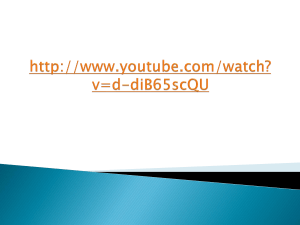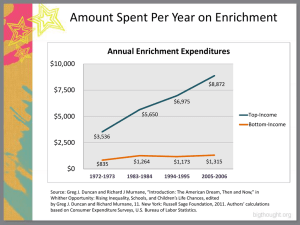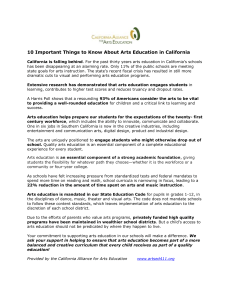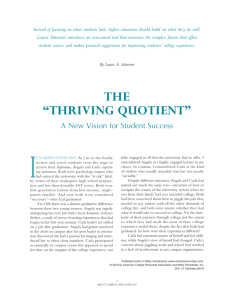Anne Ladky: An Energy Approach to Leadership. Jane Dutton
advertisement
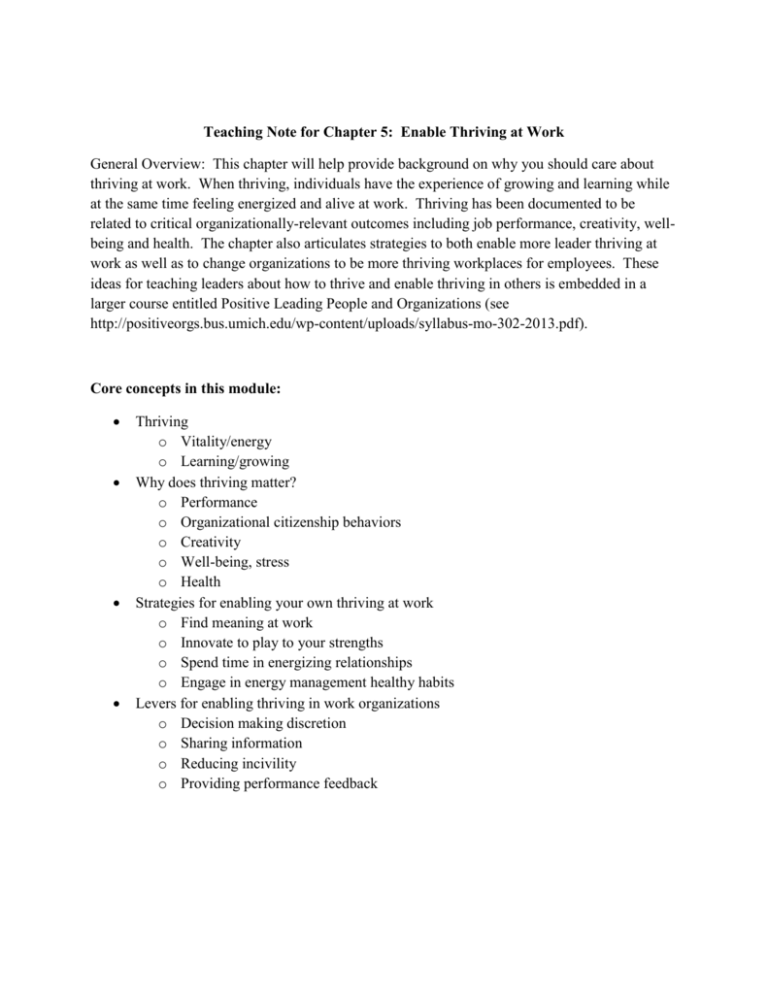
Teaching Note for Chapter 5: Enable Thriving at Work General Overview: This chapter will help provide background on why you should care about thriving at work. When thriving, individuals have the experience of growing and learning while at the same time feeling energized and alive at work. Thriving has been documented to be related to critical organizationally-relevant outcomes including job performance, creativity, wellbeing and health. The chapter also articulates strategies to both enable more leader thriving at work as well as to change organizations to be more thriving workplaces for employees. These ideas for teaching leaders about how to thrive and enable thriving in others is embedded in a larger course entitled Positive Leading People and Organizations (see http://positiveorgs.bus.umich.edu/wp-content/uploads/syllabus-mo-302-2013.pdf). Core concepts in this module: Thriving o Vitality/energy o Learning/growing Why does thriving matter? o Performance o Organizational citizenship behaviors o Creativity o Well-being, stress o Health Strategies for enabling your own thriving at work o Find meaning at work o Innovate to play to your strengths o Spend time in energizing relationships o Engage in energy management healthy habits Levers for enabling thriving in work organizations o Decision making discretion o Sharing information o Reducing incivility o Providing performance feedback Possible Class Flow Pre-work Prior to coming to class, have students complete the "energy audit" for at least two days (see appendix A). The energy audit invites students to track their energy level in hourly increments across their waking hours. They then plot their energy profile so they can see highs and lows. They also examine the kinds of activities they are doing at points of high and low energy. Individuals can also be invited to take the thriving at work assessment (see appendix B). Questions at the Start of Class Begin by asking students to reflect on their own experience with thriving. To what extent are you thriving in your work? To what extent are those in your unit thriving in their work? Why or why not? Energy Audit and Research Mini-Lecture Debrief the energy audit pre-work (see the first reading below for instructions on how to debrief) Share research on what enables thriving at work from the chapter. Ask, What strategies most resonate with me to enhance my own thriving? Which practices most resonate with me to enhance the thriving of my unit? Complete second half of the energy audit where students choose an intervention to enable more thriving in their own life. Discuss how thriving at work and in non-work activities are positively correlated. People should strive for thriving in both aspects of their lives. Supplementary Readings Energy Audit: Spreitzer, G. & Grant, T. (2012). Helping students manage their energy: Taking Their Pulse with the Energy Audit. Journal of Management Education, 36(2): 239-263. Spreitzer, G., Porath, C., & Gibson, C. (2012). Toward human sustainability: How to enable more thriving at work? Organization Dynamics, 41(2): 155-162. Reprinted in Rotman Magazine, Winter 2013, p. 17-21. University of Toronto. Spreitzer, G. and Porath, C. (2012) Creating sustainable performance. Harvard Business Review, January-February: 92-99. Fritz, C., Lam, C.F., & Spreitzer, G.M. (2011). It’s the Little Things that Matter: An Examination of Knowledge Workers’ Energy Management. Academy of Management Perspectives, 25(3): 28-39. Tools Energy Audit (see appendix A and supplementary reading above) Thriving assessment (see appendix B) Case Anne Ladky: An Energy Approach to Leadership. Jane Dutton. Globalens.com Product ID#: 1428-851. Anne Ladky, the Executive Director of a non-profit political advocacy organization called Women Employed, shares how she help employees in her organization deal with demanding work which can lead to burnout. Her leadership approach emphasizes the importance of managing employee energy at work. Appendix A: Energy Audit (I can’t add this because the formatting is different) Appendix B: Thriving Assessment This is a research derived assessment to measure thriving as definite by two dimensions of vitality (or energy) and learning. Higher scores are indicative of higher levels of thriving at work. Using the scale below, please answer the following questions in relation to your current experience at work. If you are not currently working, think about these questions with reference to your most recent job. 1 2 3 4 5 6 7 Disagree Disagree Disagree Neutral Agree Agree Agree Strongly Slightly Slightly Strongly At work… 1. …I feel alive and vital. 1 2 3 4 5 6 7 2. …I have energy and spirit. 1 2 3 4 5 6 7 3. …I am looking forward to each new day. 1 2 3 4 5 6 7 4. …I continue to learn more and more as time goes by. 1 2 3 4 5 6 7 5. …I feel very energetic. 1 2 3 4 5 6 7 6. …I am growing. 1 2 3 4 5 6 7 7. …I have developed a lot as a person. 1 2 3 4 5 6 7 8. …I feel alert and awake. 1 2 3 4 5 6 7 9. …I find myself learning often. 1 2 3 4 5 6 7 10. …I see myself continually improving. 1 2 3 4 5 6 7 To calculate a thriving score, begin by calculating the mean of the items measuring each of the thriving dimensions: Find the mean of items 1, 2, 3, 5, and 8 to create a vitality/energy score. To find a mean score, add up the scores of the 5 items and divide by 5. Find the mean of items 4, 6, 7, 9, and 10 to create a learning score. To find a mean score, add up the scores of the 5 items and divide by 5. Find the mean of the vitality/energy and learning scores.
